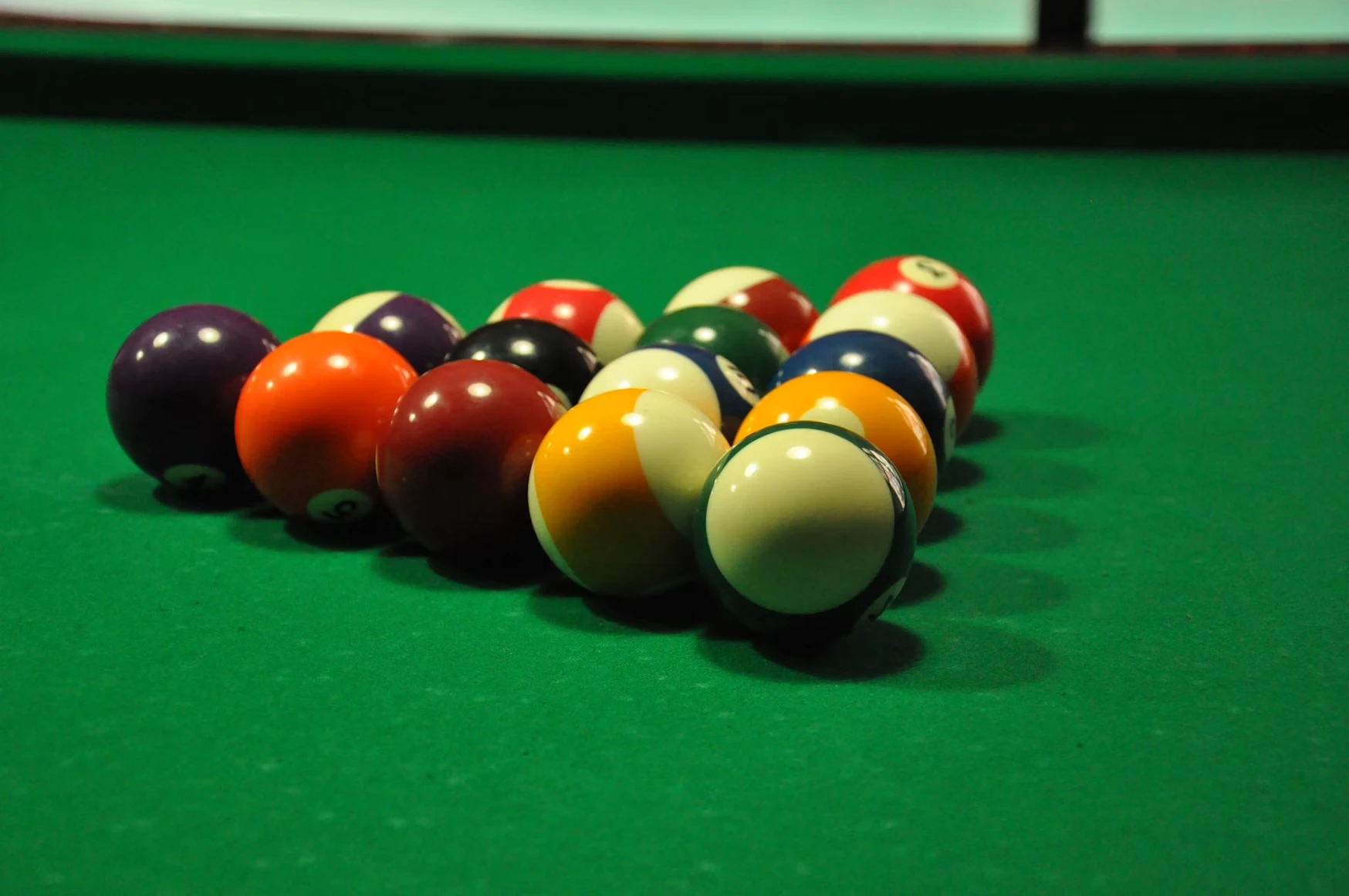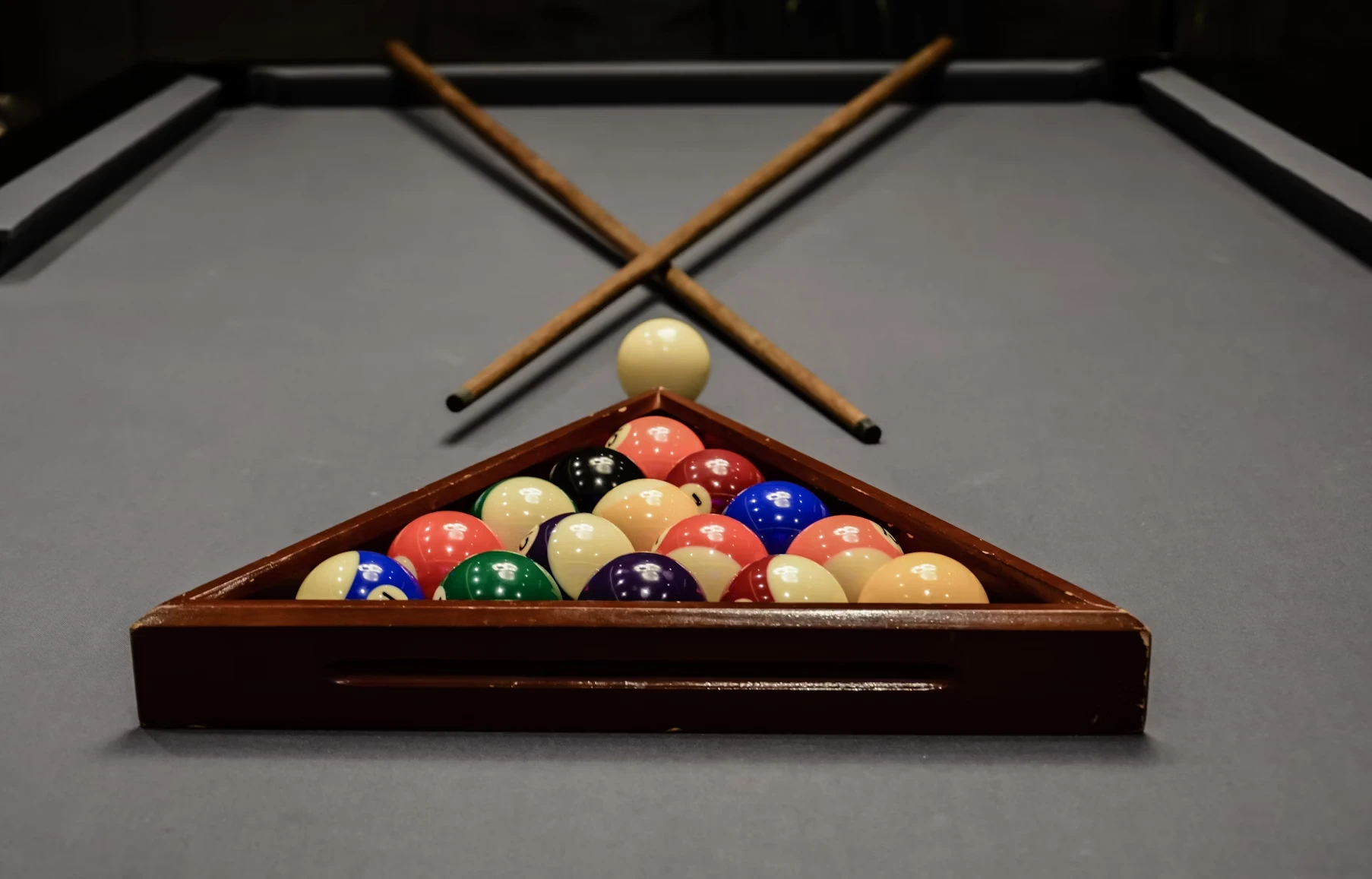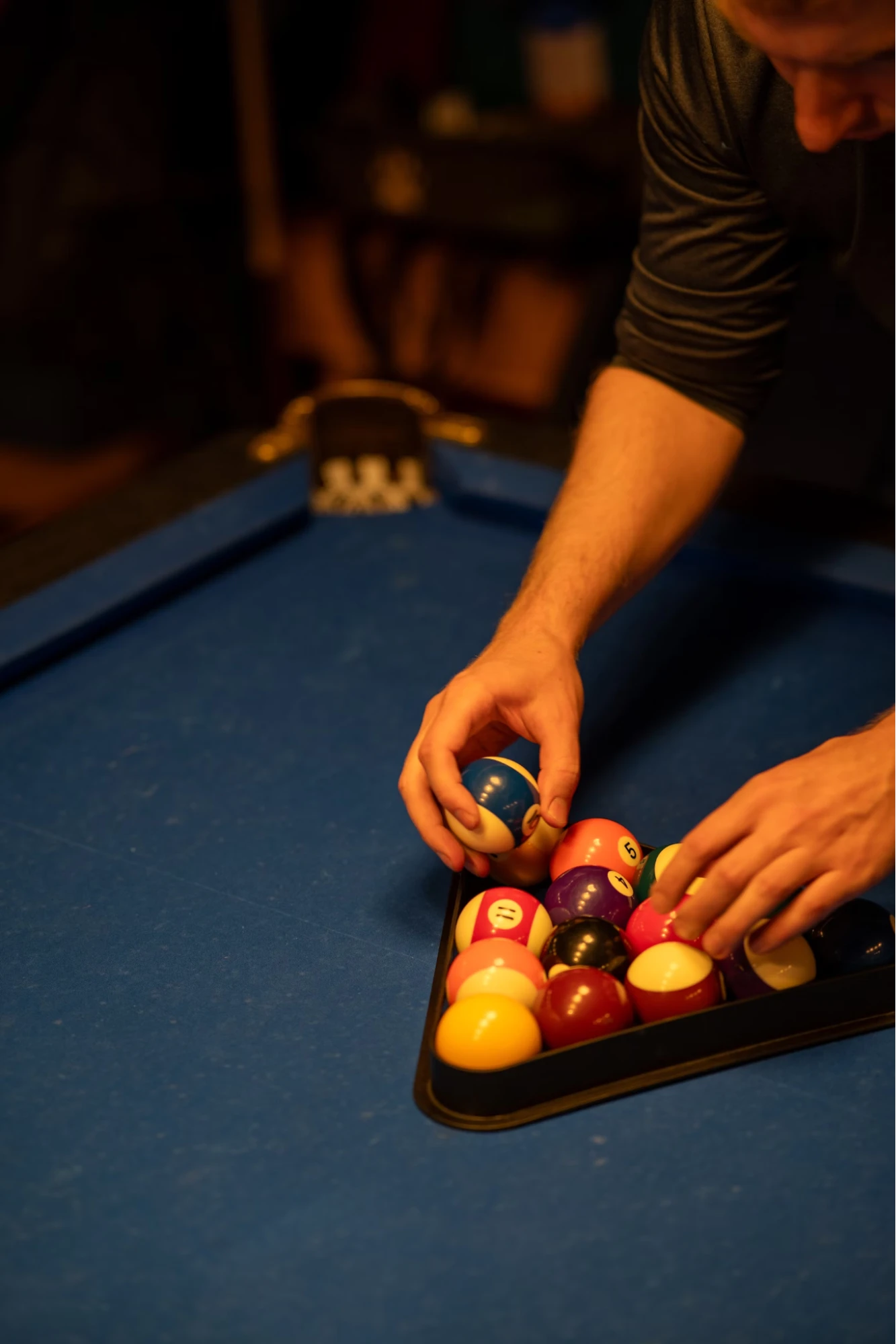How to Rack Pool Balls: A Step-by-Step Guide

If you are new to pool, learning how to rack the balls is one of the first things you learn. It involves placing balls on the table in their starting positions before the first break.
Racking pool balls is more complicated than many players think. While there are standard approaches, you will also come across alternatives (which are helpful to know if you find yourself in a different club or foreign country).
This guide covers the essentials of racking pool balls. Then, we explore how to rack tables with different rules followed by tips for perfect ball placement and common racking mistakes to avoid.
How to Rack for 8 Ball Pool
8-ball pool is the classic version of the game where you play with two players, sixteen balls, and six pockets. It’s the standard in most countries, including the U.S., and gets its name from the black 8-ball. However, its racking requirements can vary depending on the governing body that decides the underlying ruleset.
As you progress in your pool career, you will discover three standards: BAR, BCA, and APA. We discuss these in more detail below:
American Poolplayers Association (APA) Racking Rules
The APA has the most lenient racking rules, meaning there is some scope to jumble balls around. In 8-ball pool, the 8-ball must be placed in the center of the triangle, with the remaining 15 balls randomly placed around it.
Billiard Congress Of America (BCA) Rules
BCA rules are different. The 8-ball must remain in the center but players must place:
- The first ball of the rack on the foot spot
- A stripe ball on one corner
- A spot ball in the other corner
BAR Rules
Finally, some pool games use BAR rules. These require the 8-ball in the center with the first front ball of the triangle rack placed on the foot location. Then, players place the remaining balls randomly.
Other Rules
You will sometimes see different racking requirements depending on whether you are playing English 8-ball (reds & yellows) or English 8-ball (spots & stripes). American-based bodies, like the Women’s Professional Billiard Association (WPBA) sometimes specify different ball arrangements for these variations.
For example, players play English 8-ball on a British pool table (which is usually smaller than the U.S. equivalent). For reds & yellows, the two rear corners of the triangle should be different colors with alternating-color, two-ball stripes placed next to them. Then, players must place an alternating color of three further balls on the right-hand side to complete a J-shape of five balls. Two yellows then get placed in the pocket beside the central 8-ball, with the front ball the same color as the one in the rear left, and the ball behind and to the right the same color. The final ball behind the front ball should be the opposite color. The same rules apply for spots & stripes games, with the spots replacing yellows, and the stripes replacing reds.
You will also sometimes come across 9-ball pool where the racking requirements are less complex. Under BCA and APA rules, balls are numbered 1 to 9 and arranged in a diamond pattern with the 1-ball at the front and the 9-ball in the center. The remaining balls can go into the rack in any order.
Setting Up Your Pool Table Correctly

Knowing the order to arrange balls is just one part of the process. Players must also understand how to do it effectively. Many rule sets demand that players place balls as close to each other as possible, without leaving any gaps.
- Check The Table
- Use A Surface Cleaner
- Put The Rack In Place
- Check The Cushions Aren’t Fatigued
- Remove The Rack Triangle
- Check The Rest Of Your Equipment
The first step when racking is to check the table. Balls will only form a desired tight triangle shape (or diamond for 9-ball pool) if the table is level. If it isn’t, balls will roll in the direction of the slope and, in some cases, make racking impossible.
Sometimes the table is level but the felt surface is bumpy. In these situations, balls will sometimes roll away from the main pack a little, making racking more challenging. If you encounter this, remove the felt to see if there is a problem with the material below. You may need to replace it (especially if the table sees a lot of use) if you can see obvious grooves and dents.
If you think the table has debris or excessive dust, you can also use a surface cleaner to remove it. Solutions usually combine various sprays and brushes, designed to grip onto any particles and allow you to remove them with a quick sweet.
The next step is to place the rack in the spot with the table markings. Most tables have a marker but some only have a dot. Either match the triangle rack to the triangle on the table or align the front ball with the dot.
Check the rack is in the middle of the table and not swinging to one side. Double-check this point if using a dot.
Once the rack is in place, you can test the cushions for bounciness. Balls should behave predictably when coming off the cushions and there shouldn’t be any dead zones.
Once the balls are in place, remove the rack triangle carefully, minimizing brushing the balls as you lift it up. Ideally, the balls should remain still in a neat triangle (or diamond) configuration.
If you think there is a problem with the balls, check them for dents and scuffs. Sometimes, long periods of use can adjust their internal weight distribution, causing them to roll in random directions when you remove the rack’s support.
Lastly, check the rest of your equipment to ensure it works properly once the game begins. There shouldn’t be any dirt on any of the balls, and the cues should be straight and solid. If you notice anything broken, replace it.
Tips for Perfect Pool Ball Placement

Making a clean break is an essential part of pool (and even written into the rules in some associations, like the APA and BCA). As such, getting ball placement right matters, particularly in competition.
Use Racks
Historically, pool players racked balls by hand. However, this approach was inefficient and often led to balls straying from the primary group.
Racks eliminate this problem by being the perfect shape and size for standard balls, helping them cluster beautifully.
Use A Template
You can also use a template if you are new to the game. These diagrams show you where to place the balls so you don’t have to remember all the complicated rules described above.
However, always ensure you have the proper template for the rules. Layouts can vary (as discussed).
Don’t Force Balls Together
Don’t force balls together if you have an adjustable rack. Too much pressure is just as detrimental as too little. You may find yourself stuffing balls and watching them roll away from where you want them.
Keep your racking routine as consistent as you can. The more you can hone the process, the more likely it is to result in perfect racking every time.
Don’t Scrape The Felt With The Rack
Avoid scraping the felt with the rack by pushing it backward and forward with force. If you need to move it, do so gently to avoid changing the table’s surface.
Avoid Common Racking Mistakes
Finally, avoid common racking mistakes. These include:
- Failing to clean balls after each day or play or round
- Putting the balls in the wrong order on the table
- Failing to place the 8-ball in the center if using spots & stripes
- Forcing balls into the rack
- Choosing a rack that’s the wrong gauge for your balls
Of course, you can avoid all these problems by playing pool online.
Preparing for Tournament Play
Most pool games are casual social occasions. But sometimes, you may find yourself preparing for a tournament. In these cases, following proper advice can help you.
Here’s what we suggest:
- Eat balanced meals before the tournament so that you can concentrate on the game and be at your best
- Prepare yourself mentally for what’s coming by envisioning your success and what your ideal game will look like
- Develop a pre-match routine that keeps your nerves calm and prevents you from clamming up once the tournament starts
- Practice on the match table beforehand for as long as the tournament organizers allow, allowing you to get a “feel” for it before the game starts
- Avoid thinking technically before the match starts: focus on how the cue feels in your hand
- Be positive about the game and match
- Avoid expecting anything. Don’t allow yourself to celebrate until you win
- Enjoy the process
So, there you have it: our guidance for racking pool balls. Now you should know what to do every time without it seeming confusing!
Seasonal Pool Games
More Games
Pool News
Disclaimer
DISCLAIMER: The games on this website are using PLAY (fake) money. No payouts will be awarded, there are no "winnings", as all games represented by 247 Games LLC are free to play. Play strictly for fun.

































